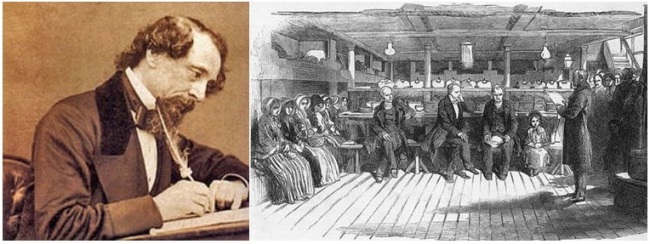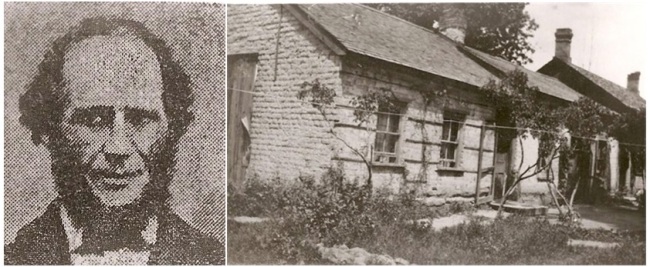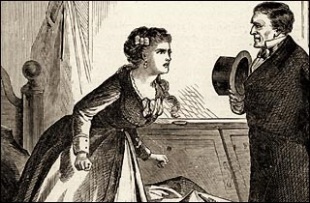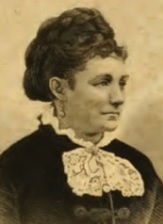Author: Christopher Ralph
PART TWO: The Spectre of Spiritual Wifery.
Much has been made by the LDS church of Charles Dickens’ visit to the emigrant ship, “Amazon”, in 1863, as part of his “Uncommercial Traveller” series of commissioned articles. Dickens expressed genuine surprise that the Mormon emigrants on board were such a well disciplined and happy people. He described them as, “in their degree, the pick and flower of England”. Yet, he also alluded to their apparent ignorance of what lay before them. Of some young women for example he wrote that he doubted they had any notion of plurality of wives in Utah, and he also recorded that while on board interviewing them, a distressed mother was searching for her daughter, claiming she had “run away with the Mormons”.
Charles Dickens commented favourably about the conduct and character of Mormon emigrants he observed on board ship in 1863.
Such events were not uncommon. William Jefferies, who converted in Bristol in 1856, recorded in his diary how he, his wife, her mother and his wife’s two brothers made their way from Bristol to Liverpool in April 1861, and there boarded an emigrant ship without the knowledge of his wife’s non-Mormon father. The father followed them and belatedly appeared on board with a police officer desperately searching for them, but could not find them hidden among the luggage.
Dickens had excellent reason to question the blind optimism of Mormon converts. There were enough tales in circulation of converts’ disillusionment upon arrival in Zion, as for example this one which is never likely to be quoted by the LDS church, but was recorded by an early branch leader in Manchester, Samuel Hawthornthwaite: “William Clough, his wife, and child, went from Ashton, in the year 1853, but he was drowned in returning. Mrs. Clough states that when they arrived in the Valley, they were entirely broken down, and nobody seemed to take any notice of them. The first sight she had of the place, sickened her. They rented a mud hut, where they lived all the winter. They never slept on a bed all the time they were there, but spread the wagon cover, which they had brought over the plains with them, on the damp earth, and there they lay, first rolling on one side, then on the other, then on their backs; and many a night did she sit up with her husband, in the dark, shivering and shaking with cold, talking about the comfortable home they had left in England.”
The story of Julia Restell, a Wiltshire convert, is particularly tragic, and well illustrates how the LDS gospel profoundly changed lives, and not always in positive ways. Her hopeful marriage in 1846 to another recent convert, George Drake, soon proved unhappy, for it seems George was not living up to his leaders’ expectations, and before long he was “cut off”, (i.e. he was excommunicated). Excommunication in those days, was usually followed by rebaptism within a few weeks or months, and was a regular method of disciplining members for relatively trivial matters such as refusing to receive counsel from their leaders. George’s excommunication would have carried with it a social stigma, (disciplinary decisions were not kept private), and probably gave rise to discord within the marriage. After eighteen months of continuing difficulty he and Julia were called to council by their Branch President, George Halliday, in an attempt to settle their differences:
“Hearing their tales I found that Brother Drake who had been rebaptised only one week before had beaten his wife and gave her a Black Eye because she did not give him money to spend and he would not tell her what he wanted to get with the money, and as he has been guilty of the same things before and would Curse and Swear, I moved that he be cut off.”
The marriage persevered uneasily for a while, and Drake was re-baptized yet again the following year, but the problems recurred, and he was once more excommunicated “for disgraceful conduct” in 1850. The policy in those days appears to have been “three strikes and you’re permanently out”, so there was by then no spiritual future for George Drake, or any likelihood of marital contentment as long as Julia wished to remain faithful to the church. This presented a significant problem because George and Julia were booked to sail nine days later from Liverpool on the “North Atlantic” emigrant ship. George abandoned Julia at that point, but evidently decided to keep to the emigration plan, making his way to Liverpool for that purpose. In view of his “three times cut off” status, probably no-one imagined he would make that choice, and so no attempt seems to have been made to prevent him from doing so. On board George presumably acted the part of a faithful member, joining others in the communal hymn singing and the usual Mormon routines, as the “North Atlantic” sailed away from Liverpool docks. Upon arrival at New Orleans on 1 November 1850, he made no attempt to cross the plains to Utah, but set out instead on a new life away from Julia and away from Mormonism.
Julia remained in Bristol and emigrated two years afterwards, but, unlike her husband, did reach Salt Lake City. She must have carried with her a letter of introduction which persuaded the church authorities there to grant her an immediate divorce, (a divorce which would not at the time have been possible, or perhaps even legal in Britain), and soon afterwards she became one of the five plural wives of Bishop Thomas W. Winter, and died giving birth to her only child in 1854. Her daughter grew up under the supervision of Winter’s other wives, and subsequently became a plural wife of Joseph Smith’s nephew, Samuel Harrison Bailey Smith.
Bishop Thomas W. Winter, and the home where he lived with his five wives and seventeen children
There was of course by this time a shortage of marriageable women in Utah because of the Mormon doctrine that faithful men aspiring to the highest degree of heavenly glory, should have more than one wife. The greater the number of wives, the greater the glory of that man in the world to come. Heber Chase Kimball, (the first missionary to Britain, but later Brigham Young’s second in command), once stated: “I think no more of taking another wife than I do of buying a cow”. On another occasion, when addressing a group of departing missionar-ies, he counselled: “The brother missionaries have been in the habit of picking out the prettiest women for them-selves before they get here, and bringing on the ugly ones for us; hereafter you have to bring them all here before taking any of them, and let us all have a fair shake.”
The doctrine of plurality of wives was not officially announced until 1852, by which time the church was becom-ing securely established in Utah, but “spiritual wifery”, (a euphemistic term signifying concubinage), had been secretly practised among a trusted inner circle of the LDS hierarchy since the late 1830s. Its existence gave rise to many rumours, and Joseph Smith even issued a spirited public denial in May 1844, in an attempt to quash them once and for all, complaining: “What a thing it is for a man to be accused of committing adultery, and having seven wives, when I can only find one.” It is very evident, however, from a series of affidavits later collected by the LDS church to prove that the practice had originated with Joseph Smith, that by the time of his public denial, Smith actually had as many as thirty-four wives, eleven of which were polyandrous unions, or women “shared” with other living husbands. It will be seen then how deeply enmeshed with Mormonism had this concept become at an early date.
The modern LDS church, while admitting polygamy was practised by some Mormons in the 19th century, does all it can to downplay and dissociate itself from the spectre of spiritual wifery. President Gordon B. Hinckley, even stated in a television interview in 1998, that he considered that polygamy was “not doctrinal”. It would be very surprising if he had been completely unaware of many statements to the contrary made by the most prominent early church leaders. The Mormon pioneers, especially the very many faithful women who unselfishly entered into that demanding form of marriage, believing they were obeying a divinely revealed eternal law of heaven, would have been deeply perplexed to hear a prophet fail to defend that highest of principles. The fact is however, that polygamy has long been a source of embarrassment to most church members, simply because its past practice is so difficult to justify, and there seem to have been no moral or social benefits. Fairly commonly these days, it is misrepresented within popular Mormon culture as having been introduced only in order to protect helpless widows, or because there were more women than men. Neither of those claims is true, but such attempts to rationalise the practice, possibly illustrate the deep unease which is still felt by many. Mormon polygamy has always been news.
It is unsurprising then that rumours of Mormon polygamy began to appear in British newspapers by the early 1840s, a full decade before it was officially adopted in 1852. A 17 year old convert, Martha Brotherton, a native of Manchester, England, in 1842 emigrated with some of her family to Nauvoo, Illinois, (then the headquarters of the LDS church), and later that year publicly declared in an affidavit, that soon after her arrival Brigham Young and Joseph Smith had met with her in a locked room, and tried to coerce her into becoming Brigham’s plural wife. This was her introduction to the concept of spiritual wifery, and when she resisted the idea, Smith generously suggested that if she did not like the thought of Brigham being her husband, then she might have him instead. Her public disclosure of these events naturally caused great intrigue and excitement.
An early anti-Mormon depiction of Martha Brotherton’s indignation upon hearing Brigham Young’s proposal
The church hierarchy of the day vehemently denied that any such practice was permissible within LDS circles, and Smith retaliated strongly, referring to Martha Brotherton as “a mean harlot”. News of this filtered back to England, where Martha’s former reputation had in no way justified Smith’s name-calling. Parley Pratt, the head of the British Mission responded to the situation by going on the offensive in the LDS newspaper, The Millennial Star, branding her a liar and, (possibly disclosing his deeper concerns), added:
“By these disreputable means she thought to overthrow the Saints here, or at least to bring a storm of persecution upon them, and prevent others from joining them; but in this thing she was completely deceived by Satan. Her proceedings have had no other effect upon the Saints than to fill them with mingled feelings of pity and contempt towards her… for the information of those who may be assailed by those foolish tales about the two wives, we would say that no such principle ever existed among the Latter-Day Saints, and never will”
Pratt’s emphatic words were not without irony however, for the following year, having returned to Nauvoo, he himself took Martha Brotherton’s older sister Elizabeth as a plural wife! It is not really surprising though that he was so duplicitous. On one occasion he was quoted as advising the priesthood brethren: “we must lie to support Brother Joseph; it is our duty to do so.” Character assassination was acceptable if it protected the reputation of the prophet. However, history has fully vindicated Martha Brotherton, for several other testimonies on record persuasively witness that her case was far from unique; in addition to the thirty or so who submitted to Joseph Smith’s advances, more than a dozen other women when similarly propositioned, refused him, and were subsequently vilified for doing so. When the various accounts are assembled into one cohesive narrative, it is sadly rather obvious what was actually taking place around Joseph Smith in the name of religion.
Fanny Stenhouse (nee Warn) a convert in Southampton, and later a critic of polygamy.
Fanny Warn joined the church in Southampton in 1849, and the following year married Thomas Stenhouse, a very committed Scottish convert. Describing the character of the British Mormons of that era, she wrote they were “an earnest religious people, in many respects like the Methodists, especially in their missionary zeal and fervor of spirit”, adding that “the name of Joseph Smith was seldom spoken, and still more seldom was heard the name of Brigham Young… at that time polygamy was unheard of as a doctrine of the Saints”. Polygamy as practised by the top brass of the church in America was a carefully guarded secret within the British church, known only to an inner circle of trusted high-ranking church officials. Any rumours reported back in letters by disillusioned emigrants were always countered by fierce denials, and anyone spreading such suspicions was immediately branded “anti-Mormon”, a disparaging label which, even to this day, is rather liberally applied to critics in order to nullify all credibility in the eyes of LDS members.
“How different,” lamented Fanny, “practical Mormonism in Utah was from the theoretical Mormonism… in Europe, before polygamy was known among the Saints”. She was, by then, writing from unhappy personal experience decades later, and went on to relate how she had known a young couple in comfortable circumstances in England, who had given up everything to emigrate, but upon arrival in Salt Lake City, “were soon utterly disgusted by what they witnessed, apostatized, and set out for England”. On their way back east across the plains they and their child were killed, supposedly by Indians, although some suspected that their deaths had resulted from orders given by the LDS leadership.
An outrageous claim? It would be nice to think so, but when one considers some of the extreme statements of those early leaders, to the effect that when certain institutional loyalties and commandments had been breached, the most considerate thing to do, was to shed the blood of guilty parties, so that they might atone for their own sins, then such an appalling scenario, unfortunately, is not quite as far-fetched as at first appears… even though it might seem completely alien to Mormons of the present day.
As alien in fact as polygamy.
(to be continued)















Leave a Reply